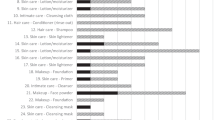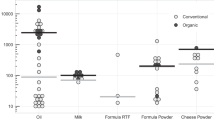Abstract
Flavorings are substances that alter or enhance the taste of food. Workers in the food-manufacturing industry, where flavorings are added to many products, may be exposed to any number of flavoring compounds. Although thousands of flavoring substances are in use, little is known about most of these in terms of worker health effects, and few have occupational exposure guidelines. Exposure assessment surveys were conducted at nine food production facilities and one flavor manufacturer where a total of 105 area and 74 personal samples were collected for 13 flavoring compounds including five ketones, five aldehydes, and three acids. The majority of the samples were below the limit of detection (LOD) for most compounds. Diacetyl had eight area and four personal samples above the LOD, whereas 2,3-pentanedione had three area samples above the LOD. The detectable values ranged from 25–3124 ppb and 15–172 ppb for diacetyl and 2,3-pentanedione respectively. These values exceed the proposed National Institute for Occupational Safety and Health (NIOSH) recommended exposure limit for these compounds. The aldehydes had the most detectable samples, with each of them having >50% of the samples above the LOD. Acetaldehyde had all but two samples above the LOD, however, these samples were below the OSHA PEL. It appears that in the food-manufacturing facilities surveyed here, exposure to the ketones occurs infrequently, however levels above the proposed NIOSH REL were found. Conversely, aldehyde exposure appears to be ubiquitous.
This is a preview of subscription content, access via your institution
Access options
Subscribe to this journal
Receive 6 print issues and online access
$259.00 per year
only $43.17 per issue
Buy this article
- Purchase on Springer Link
- Instant access to full article PDF
Prices may be subject to local taxes which are calculated during checkout
Similar content being viewed by others
References
Akpinar-Elci M, Travis WD, Lynch DA, Kreiss K . Bronchiolitis obliterans syndrome in popcorn production plant workers. Eur Respir J 2004; 24 (2): 298–302.
Kanwal R Letter of July 2, 2003, from R. Kanwal, Division of Respiratory Disease Studies, National Institute for Occupational Safety and Health, Centers for Disease Control and Prevention, Department of Health and Human Services, to Frank Morrison, Nebraska Popcorn. Clearwater, NE 2003.
Kanwal R, Martin S Letter of May 13, 2003, from R. Kanwal and S. Martin, Division of Respiratory Disease Studies, National Institute for Occupational Safety and Health, Centers for Disease Control and Prevention, Department of Health and Human Services, to Keith Heuermann, B.K. Heuermann Popcorn, Inc. Phillips, NE 2003.
Kanwal R, Kullman G, Piacitelli C, Boylstein R, Sahakian N, Martin S et al. Evaluation of flavorings-related lung disease risk at six microwave popcorn plants. J Occup Environ Med 2006; 48 (2): 149–157.
NIOSH: "Hazard evaluation and technical assistance report: American Pop Corn Company, Sioux City, IA." U.S. Department of Health and Human Services, Centers for Disease Control and Prevention, National Institute for Occupational Safety and Health, Cincinnati, OH, 2004.
Martyny JW, Van Dyke MV, Arbuckle S, Towle M, Rose CS . Diacetyl exposures in the flavor manufacturing industry. J Occup Environ Hyg 5 (11): 679–688 2008.
Parmet AJ, Von Essen S . Rapidly progressive, fixed airway obstructive disease in popcorn workers: a new occupational pulmonary illness? J Occup Environ Med 44 (3): 216–218 2002.
Ashley K, McKernan LT, Burroughs E, Deddens J, Pendergrass S, Streicher RP . Analytical performance criteria. Field evaluation of diacetyl sampling and analytical methods. J Occup Environ Hyg 5 (11): D111–D116 2008.
Kreiss K, Kullman GA, Fedan G, Simoes K, Enright EJ . PL Clinical bronchiolitis obliterans in workers at a microwave-popcorn plant. N Engl J Med 347 (5): 330–338 2002.
Alleman T . Case report: bronchiolitis obliterans organizing pneumonia in a spice process technician. J Occup Environ Med 44 (3): 215–216 2002.
CDC. Obliterative bronchiolitis in workers in a coffee-processing facility - Texas, 2008-2012. MMWR Morb Mortal Wkly Rep 2013; 62 (16): 305–307.
NIOSH. "Health Hazard Evaluation: International Bakers Services - Indiana; July 1986. HETA 85-171-1710.". US Department of Health and Human Services, Centers for Disease Control and Prevention. National Instuitute for Occupational Safety and Health: Cincinnati, OH. 1986.
Day G, LeBouf R, Grote A, Pendergrass S, Cummings K, Kreiss K et al. Identification and measurement of diacetyl substitutes in dry bakery mix production. J Occup Environ Hyg 2011; 8 (2): 93–103.
Boylstein R . Case study: identification of diacetyl substitutes at a microwave popcorn production plant. J Occup Environ Hyg 2012; 9: D33–D34.
Hubbs AF, Moseley AE, Goldsmith WT, Jackson MC, Kashon ML, Battelli LA et al. Airway epithelial toxicity of the flavoring agent, 2,3-pentanedione. J Soc Toxicol 2010; 114 (S-1): 319.
Morgan DL, Jokinen MP, Price HC, Bosquet RW, Taylor GJ, Gage N et al. Inhalation toxicity of acetyl proprionyl in rats and mice. Abstract 1492. The Toxicologist 2010; 114 (S-1): 316.
Morgan DL, Jokinen MP, Price HC, Gwinn WM, Palmer SM, Flake GP . Bronchial and bronchiolar fibrosis in rats exposed to 2,3-pentanedione vapors: implications for bronchiolitis obliterans in humans. Toxicol Pathol 2012a; 40 (3): 448–465.
Morgan DL, Jokinen MP, Johnson CL, Gwinn WM, Price HC, Flake GP . Bronchial fibrosis in rats exposed to 2,3-butanedione and 2,3-pentanedione vapors. Toxicol Sci 2012b; 126: 186.
ACGIH 2012 TLVs and BEIs: threshold limit values for chemical substances and physical agents and biological exposure indices. Cincinnati, OH: American Conference of Governmental Industrial Hygienists 2012.
NIOSH. "Criteria for a Recommended Standard, Diacetyl and 2, 3-Pentanedione, National Institute for Occupational Safety and Health Pub # xxxxxx.". US Department of Health and Human Services, Centers for Disease Control and Prevention. National Instuitute for Occupational Safety and Health: Cincinnati, OH. 2013.
FEMA. "Respiratory Health and Safety in the Flavor Manufacturing Workplace". The Flavor and Extract Manufacturers Association of the United States: Washington. 2004.
NIOSH: "Health Hazard Evaluation: Lung function (Spirometry) testing in employees at a flavorings manufacturing plant – Indiana; June 2011. HETA 2008-0155-3131." US Department of Health and Human Services, Centers for Disease Control and Prevention, National Instuitute for Occupational Safety and Health, Atlanta, GA 2011.
Jurvelin J, Vartiainen M, Jantunen M, Pasanen P . Personal exposure levels and microenvironmental concentrations of formaldehyde and acetaldehyde in the Helsinki metropolitan area, Finland. J Air Waste Manag Assoc 51 (1): 17–24 2001.
Spengler JD, McCarthy JF, Samet JM . Indoor Air Quality Handbook. McGraw-Hill Professional Publishing: New York, NY. 2000.
EPA: "Health Assessment Document for Acetaldehyde. EPA/600/8-86-015A." US Environmental Protection Agency, Environmental Criteria and Assessment Office, Office of Health and Environmental Assessment, Office of Research and Development, Research Triangle Park, NC 1987.
NIOSH. "NIOSH Pocket Guide to Chemcial Hazards. DHHS (NIOSH) Publication No. 2005-149.". US Department of Health and Human Services, Centers for Disease Control and Prevention. National Institute for Occupational Safety and Health: Cincinnati, OH. 2007.
IARC. "IARC Monographs on the Evaluation of Carcinogenic Risks to Humans Volume 71: Re-evaluation of Some Organic Chemicals, Hydrazine and Hydrogen Peroxide.". World Health Organization. International Agency for Research on Cancer: Lyon, France. 1999.
van Rooy FG, Rooyackers JM, Prokop M, Houba R, Smit LA, Heederik DJ . Bronchiolitis obliterans syndrome in chemical workers producing diacetyl for food flavorings. Am J Respir Crit Care Med 2007; 176 (5): 498–504.
Acknowledgements
The authors thank the many NIOSH colleagues who assisted on the study, in particular Kevin H. Dunn and James Couch for help with the study development; Alberto Garcia, Kevin L. Dunn, Karl Feldmann, Ken Sparks, Matt Dam, Steve Bertke and Steve Wurzelbacher with sample collection; and Shawna Watts for travel arrangements. The authors are indebted to Marianne Yencken and Jennifer Cohen of Battelle for their tireless efforts in company recruitment.
Author information
Authors and Affiliations
Corresponding author
Ethics declarations
Competing interests
The authors declare no conflict of interest.
Additional information
The findings and conclusions in this report are those of the authors and do not necessarily represent the views of the National Institute for Occupational Safety and Health.
Rights and permissions
About this article
Cite this article
Curwin, B., Deddens, J. & McKernan, L. Flavoring exposure in food manufacturing. J Expo Sci Environ Epidemiol 25, 324–333 (2015). https://doi.org/10.1038/jes.2014.52
Received:
Accepted:
Published:
Issue Date:
DOI: https://doi.org/10.1038/jes.2014.52



